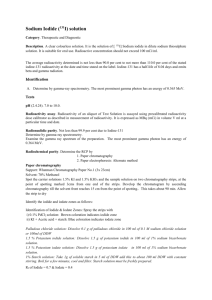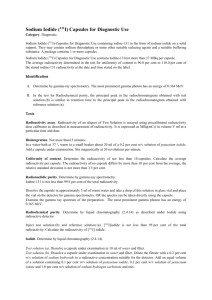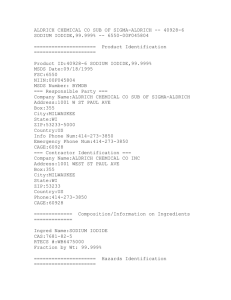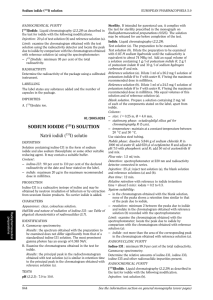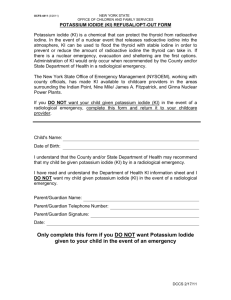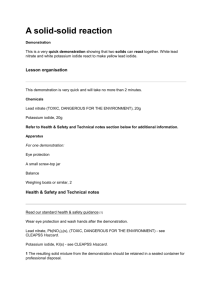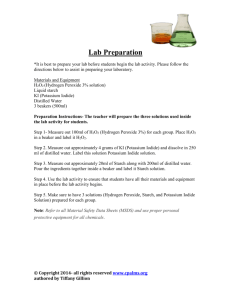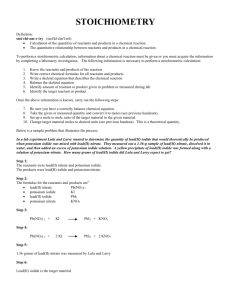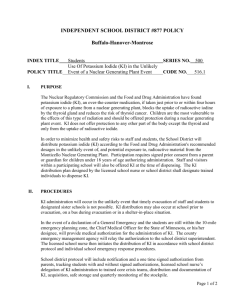Sodium Iodide (131I) Capsules For Therapeutic Use
advertisement
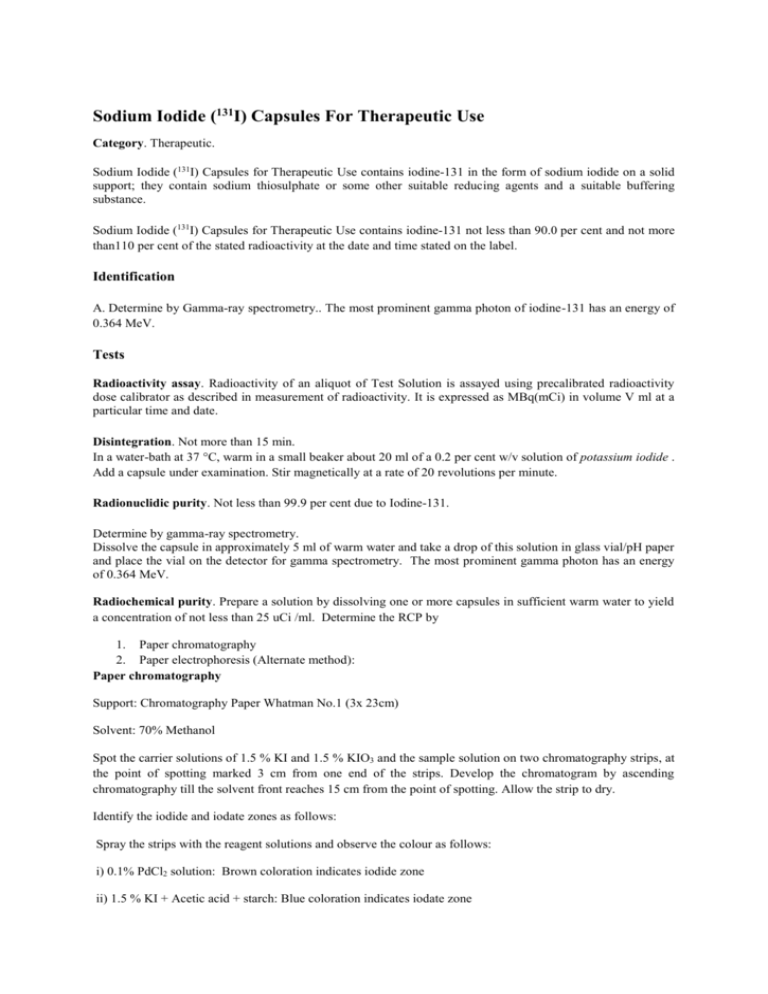
Sodium Iodide (131I) Capsules For Therapeutic Use Category. Therapeutic. Sodium Iodide (131I) Capsules for Therapeutic Use contains iodine-131 in the form of sodium iodide on a solid support; they contain sodium thiosulphate or some other suitable reducing agents and a suitable buffering substance. Sodium Iodide (131I) Capsules for Therapeutic Use contains iodine-131 not less than 90.0 per cent and not more than110 per cent of the stated radioactivity at the date and time stated on the label. Identification A. Determine by Gamma-ray spectrometry.. The most prominent gamma photon of iodine-131 has an energy of 0.364 MeV. Tests Radioactivity assay. Radioactivity of an aliquot of Test Solution is assayed using precalibrated radioactivity dose calibrator as described in measurement of radioactivity. It is expressed as MBq(mCi) in volume V ml at a particular time and date. Disintegration. Not more than 15 min. In a water-bath at 37 °C, warm in a small beaker about 20 ml of a 0.2 per cent w/v solution of potassium iodide . Add a capsule under examination. Stir magnetically at a rate of 20 revolutions per minute. Radionuclidic purity. Not less than 99.9 per cent due to Iodine-131. Determine by gamma-ray spectrometry. Dissolve the capsule in approximately 5 ml of warm water and take a drop of this solution in glass vial/pH paper and place the vial on the detector for gamma spectrometry. The most prominent gamma photon has an energy of 0.364 MeV. Radiochemical purity. Prepare a solution by dissolving one or more capsules in sufficient warm water to yield a concentration of not less than 25 uCi /ml. Determine the RCP by 1. Paper chromatography 2. Paper electrophoresis (Alternate method): Paper chromatography Support: Chromatography Paper Whatman No.1 (3x 23cm) Solvent: 70% Methanol Spot the carrier solutions of 1.5 % KI and 1.5 % KIO3 and the sample solution on two chromatography strips, at the point of spotting marked 3 cm from one end of the strips. Develop the chromatogram by ascending chromatography till the solvent front reaches 15 cm from the point of spotting. Allow the strip to dry. Identify the iodide and iodate zones as follows: Spray the strips with the reagent solutions and observe the colour as follows: i) 0.1% PdCl2 solution: Brown coloration indicates iodide zone ii) 1.5 % KI + Acetic acid + starch: Blue coloration indicates iodate zone Palladous chloride solution: Dissolve 0.1 g of palladous chloride in 100 ml of 0.1 M sodium chloride solution or 100ml of DDW 1.5 % Potassium iodide solution: Dissolve 1.5 g of potassium iodide in 100 ml of 1% sodium bicarbonate solution. 1.5 % Potassium iodate solution: Dissolve 1.5 g of potassium iodate in 100 ml of 1% sodium bicarbonate solution. 1% Starch solution: Take 1g of soluble starch in 5 ml of DDW add this to about 100 ml DDW with constant stirring. Boil for a few minutes, cool and filter. Starch solution must be freshly prepared. Rf of Iodide = 0.7 & Iodate = 0.4 Scan the strip using the radiochromatogram scanner with the collimator suitable adjusted to measure into 1cm sections and count in a NaI(Tl) well type scintillation counter. 131 I or cut Calculate RCP as the % of radio activity present in the form of Na 131I as follows: (%) RCP = Radioactivity in the Iodide zone x 100 / Total Activity The radioactivity in the iodide zone shall not be less than 95% of the total activity. Paper electrophoresis Support: Whatman No.3 Chromatography Paper (3x 34cm) Solvent: 0.05M Na2HPO4 , pH 7.5 Wash the electrophoresis bath with DDW; add 150ml of 0.05M Na 2H PO4 solution in each compartment. Take two strips of Whatman No.1 paper, 3 x 34 cm; mark the point of spotting at 6 cm from one end. Moisten the strips with 0.05M Na2H PO4 solution; remove the excess solution by blotting on an absorbent sheet. Mount them on the bridge with the point of spotting at the cathode end. Switch on the electrophoresis unit and run for 5 min at 240 volts for saturation. Put off the electrophoresis unit and spot the carrier solutions of KI and KIO 3 and the sample (dissolve one capsule in 5 ml of warm water).Switch on the unit and allow the strip to run for 35 min. at 240 V. Switch off, remove the strips, allow to dry. Identify the iodide and iodate zones as described above Scan the strip using radiochromatogram scanner with the collimator suitable adjusted to measure 131I or cut the strips into 1cm sections and count in a NaI(Tl) well type scintillation counter. Calculate the RCP as % of radioactivity present in the form of iodide as described under paper Chromatography. The activity in the iodide zone shall not be less than 95% of the total activity Storage: To be stored in a cool and dark place with adequate shielding. Expiry :. 2 weeks from reference date for 3 & 5 mCi capsules. 4 weeks from reference date for 10 mCi capsules. Labelling. The label states , in addition to the information specified under injections (1) the time and date of calibration (2) the amount of 131I as total megabecquerels (millicuries) and concentration as megabecquerels (millicuries) per ml at the time of calibration (3) the expiration date (4) ) the statement “ caution- radioactive material”
